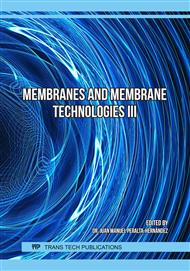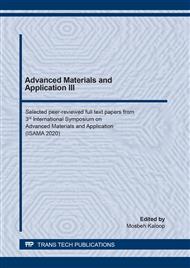p.29
p.34
p.41
p.47
p.52
p.59
p.65
p.71
p.76
Pebax 1657 Nanocomposite Membranes Incorporated with Nanoadsorbent Derived from Oil Palm Frond for CO2/CH4 Separation
Abstract:
Membrane technology has attracted significant attention from the researchers, especially in gas separation process due to their simple process design and low capital cost compared to conventional techniques. In this work, oil palm frond (OPF) waste was used as nanoadsorbent embodied in polyether block amide (Pebax 1657) nanocomposite membrane to improve the CO2/CH4 separation. The effectiveness of the nanoadsorbent derived from OPF was evaluated by varying the nanoadsorbent concentration (2–8 wt %) and controlling the Pebax 1657 concentration (5 wt %), dipping time (5 s), and number of sequential coatings (3 layers). The pore characteristics of the nanoadsorbent was analyzed using Brunauer–Emmett–Teller (BET) analysis. The morphology and the existence of active groups in the newly synthesized nanoadsorbent and nanocomposite membranes were investigated using field emission scanning electron microscopy (FESEM) and Fourier transform infrared spectroscopy (FTIR), respectively. The single gas permeation process was carried out at constant pressure (2 bar) and room temperature (25 ± 5 °C). The optimum condition with 5 wt % nanoadsorbent made the nanocomposite membrane exceeded the trade-off limit of the Robeson plot with a CO2 permeability and CO2/CH4 selectivity of 1475.09 Barrer and 40.48, respectively.
Info:
Periodical:
Pages:
52-58
Citation:
Online since:
August 2020
Price:
Сopyright:
© 2020 Trans Tech Publications Ltd. All Rights Reserved
Share:
Citation:



